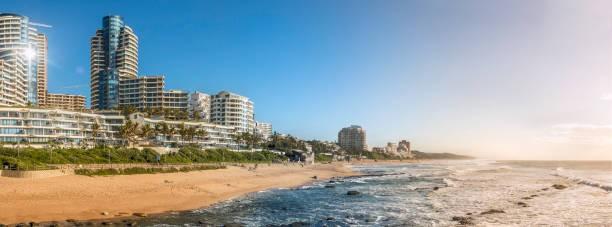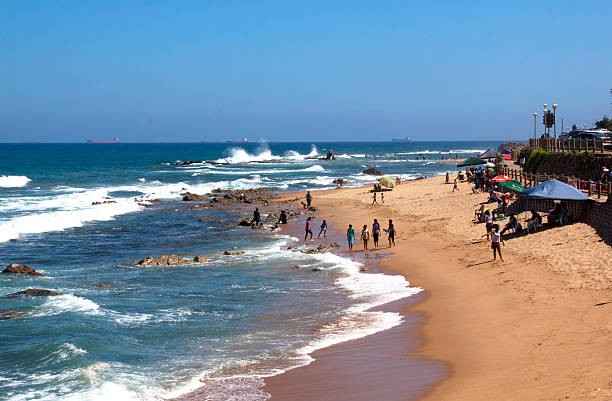Durban beaches are no longer the place for comfort and relaxation

Once upon a time the Durban beaches were the go-to for everyone. Where swimming happened and where music concerts happened, families and loved ones would not miss the opportunity to go to the beach. The beach was a place for fun, peace, comfort, relaxation, and healing, but everything has changed for the worse. The question that everyone asks is what happened because everything has fallen apart and is now black and white.
Walking on the beach was filled with sand and bright sunlight but now is filled with littering of plastic cups, bags, straws, etc. Remember the days in summer in the festive season when the beaches were packed with people from other provinces touching and smelling the beauty of the ocean. South African people coming together and speaking diverse types of languages together and dancing together with oceans. It was really the days of fun where memories were created, but now people can only look at the beach and only hear about it.
Humans and environmental pollution have an impact on the Durban beaches. They are no longer satisfying and interesting because of the dirt and high crime rate. People are afraid of being robbed and mugged, as every day something bad happens. The Durban beaches have become dangerous, especially for children. Last week on Friday a blue Polo Vivo car in the South Beach area took eight children that were swimming; till today they have not been found and are not traceable. The community is shocked and devastated, and the children’s families are begging for help. Human trafficking can never stop because some people are evil and love to see other people miserable. The people that were in the blue car are known for human trafficking and send children to various parts of Africa. The Durban community is working together to catch these culprits and bring back the children.
Should we blame humans and the environmental issues?
No one goes to the beaches because of all these issues, and the question is when it all will stop because South Africa cannot be having issues anymore. The more the crime rate increases, the more it affects the growth of South Africa. Since Durban beaches have become a place for crime and pain, more people are not interested in going to them. Change is needed, and enough is not enough if we don’t work together as a community.
Protect the Durban beaches and the community

My final words are protecting the beaches is essential, and tell those around to fight crime and spread kindness.
Durban beaches are the warmest place to be and should remain that way.
What is the most beautiful beach in Durban?
As with all such “most beautiful” lists, which beach in Durban is the most beautiful is a matter of opinion, and, just as Mayo was the first beach to win blue flag status, so many insist it is the most beautiful of the lot.
Blue Lagoon Beach: Famous for its scenery where waves hit the rock (perfect for your photos and relaxation). It’s a popular fishing location and considered beautiful and not crowded.
Durban Beach Front: It’s renowned for having clean beaches, great waves for swimming, and an entertaining atmosphere. It provides facilities like wet areas for swimming, showering, and picnicking, and is regarded as very pretty with golden sea sand.
uMhlanga Main Beach: This is the safest Durban beach and is characterized by long golden stretches of sand, perfect for families and children. It also has beautiful sunrise views of the Indian Ocean.
Ansteys Beach: A beautiful long stretch of clean beach, ideal for surfing in warm water, with children’s play pools.
Suncoast Beach: This beach, spaces permitting, is beautiful and clean with a placid seashore and fantastic views of the Golden Mile. It’s also close to the Suncoast hotel and restaurants.
Conclusion:
The Durban coast has a combination of safe and unsafe bathing (based on water quality alone), as E. coli infections are dependent on what type of organism is present and are not an accurate general disease indicator. Umhlanga Lighthouse, North Beach, Golden Mile, and uShaka Beach are among the beaches considered safe to swim, while high E. coli levels have been recorded at the Umgeni River mouth and may prove dangerous. The eThekwini Municipality manages and samples the quality of beach water to promote safe recreational use by residents and visitors.
Frequently Asked Questions (FAQs):
Q1. Does Durban have good beaches?
Q2. How many beaches are in Durban?
There are 600 km of subtropical beaches on the hot Indian Ocean coastline with KwaZulu-Natal and Durban at its center.
Q3. Is Durban Beach safe to swim in?
“Four beaches—Umhlanga Lighthouse, North Beach, Golden Mile, and uShaka Beach—met regulatory requirements for E. coli from a microbiological testing perspective and are safe for bathing and recreational use,” said Professor Bux.
Q4. How many beaches in Durban have?
There are 21 beaches open for swimming in Durban until 20 January 2025. eThekwini Municipality maintains these beaches. uShaka, Addington, North Beach, and Umhlanga are some of the favorite beaches. Two beaches are closed because of water quality.


